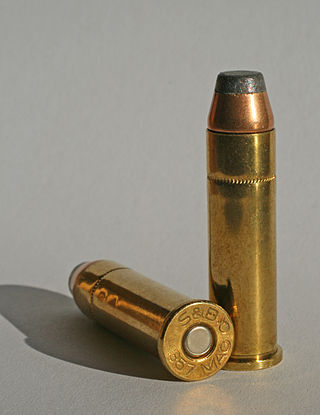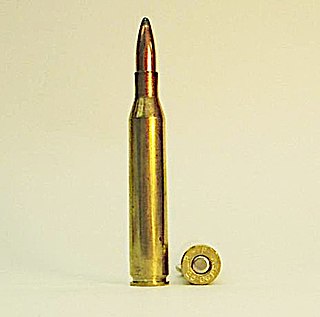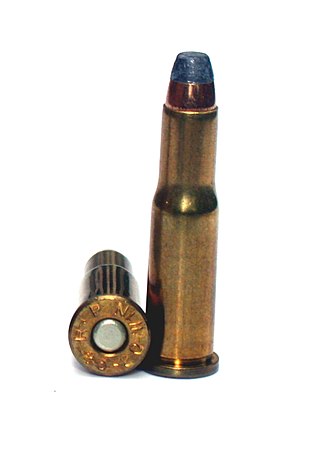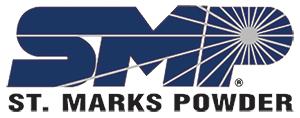Handloading, or reloading, is the practice of making firearm cartridges by assembling the individual components, rather than purchasing mass-assembled, factory-loaded ammunition.

A center-fire is a type of metallic cartridge used in firearms, where the primer is located at the center of the base of its casing. Unlike rimfire cartridges, the centerfire primer is typically a separate component seated into a recessed cavity in the case head and is replaceable by reloading the cartridge.

Smokeless powder is a type of propellant used in firearms and artillery that produces less smoke and less fouling when fired compared to black powder. Because of their similar use, both the original black powder formulation and the smokeless propellant which replaced it are commonly described as gunpowder. The combustion products of smokeless powder are mainly gaseous, compared to around 55% solid products for black powder. In addition, smokeless powder does not leave the thick, heavy fouling of hygroscopic material associated with black powder that causes rusting of the barrel.
The .30-06 Springfield cartridge, 7.62×63mm in metric notation, and called the .30 Gov't '06 by Winchester, was introduced to the United States Army in 1906 and later standardized; it remained in military use until the late 1970s. In the cartridge's name, ".30" refers to the nominal caliber of the bullet in inches; "06" refers to the year the cartridge was adopted, 1906. It replaced the .30-03 Springfield, 6mm Lee Navy, and .30-40 Krag cartridges. The .30-06 remained the U.S. Army's primary rifle and machine gun cartridge for nearly 50 years before being replaced by the 7.62×51mm NATO and 5.56×45mm NATO, both of which remain in current U.S. and NATO service. The cartridge remains a very popular sporting round, with ammunition produced by all major manufacturers.

A wildcat cartridge, often shortened to wildcat, is a custom cartridge for which ammunition and/or firearms are not mass-produced. These cartridges are often created in order to optimize a certain performance characteristic of an existing commercial cartridge, or may merely be intended as novelty items.

The .30-40 Krag, also known as the .30 U.S. and .30 Army, was a rifle cartridge developed in the early 1890s to provide the U.S. armed forces with a smokeless powder cartridge suited for use with modern small-bore repeating rifles to be selected in the 1892 small arm trials. Since the cartridge it was replacing was the .45-70 Government, the new cartridge was considered small-bore at the time. The rifle ultimately selected for use by the Army was the Krag–Jørgensen, formally adopted as the M1892 Springfield. The cartridge was also used in the M1893, M1895, M1897, and M1900 Gatling guns.

Considered by many as the most balanced of the "quarter bores" for hunting medium-sized game, the .25-06 Remington remained in obscurity as a wildcat cartridge for nearly half a century before being standardized by Remington in 1969.

The 6.5×52mm Carcano, also known as the 6.5×52mm Parravicini–Carcano or 6.5×52mm Mannlicher–Carcano, is an Italian military 6.5 mm rimless bottle-necked rifle cartridge, developed from 1889 to 1891 and used in the Carcano 1891 rifle and many of its successors. A common synonym in American gun literature is "6.5mm Italian." In American parlance, "Carcano" is frequently added to better distinguish it from the rimmed hunting cartridge 6.5×52mmR. Ballistically, its performance is very similar to that of the 6.5×54mm Mannlicher–Schönauer.

Martini–Enfield rifles were, by and large, conversions of the Zulu War era .577/450 Martini–Henry, rechambering the rifle for use with the newly introduced .303 British cartridge. Whilst most Martini–Enfields were converted rifles, a number were newly manufactured as well.

The .25-20 Winchester, or WCF, was developed around 1895 for the Winchester Model 1892 lever action rifle. It was based on necking down the .32-20 Winchester. In the early 20th century, it was a popular small game and varmint round, developing around 1,460 ft/s with 86-grain bullets. But two years earlier Marlin Firearms Co. had already necked down the .32-20 Winchester, and called it the .25-20 Marlin. It was first chambered in Model 1889 lever action Marlins long before Winchester did the same thing and put their name on the .25-20.

A gas check is a gasket type component of firearms ammunition. Gas checks are used when non-jacketed bullets are used in high pressure cartridges. The use of a gas check inhibits the buildup of lead in the barrel and improves accuracy.

The .50-90 Sharps, also known as the .50-21⁄2" Sharps, is a black-powder rifle cartridge cartridge that was introduced by Sharps Rifle Manufacturing Company in 1872 as a buffalo hunting round. Like other large black-powder rounds, it incorporates a heavy bullet and a large powder volume, leading to high muzzle energies.

The .275 Holland & Holland Magnum is a semi-obsolete rifle cartridge similar to the 7mm Remington Magnum. Essentially the .275 Holland & Holland Magnum is a necked down shortened variant of the .375 Holland & Holland Magnum. It was introduced by the British company Holland & Holland with the .375 Holland & Holland Magnum that was introduced in 1912 as the .375 Belted Rimless Nitro-Express. The .375 Holland & Holland Magnum was intended for dangerous African game animals, while the .275 Holland & Holland Magnum was intended for longer range shooting of antelope in Africa and Red Stag in the highlands of Scotland.

Improved military rifle propellants are tubular nitrocellulose propellants evolved from World War I through World War II for loading military and commercial ammunition and sold to civilians for reloading rifle ammunition for hunting and target shooting. These propellants were DuPont modifications of United States artillery propellants. DuPont miniaturized the large artillery grains to form military rifle propellants suitable for use in small arms. These were improved during the First World War to be more efficient in rimless military cartridges replacing earlier rimmed rifle cartridges. Four-digit numbers identified experimental propellants, and a few successful varieties warranted extensive production by several manufacturers. Some were used almost exclusively for military contracts, or commercial ammunition production, but a few have been distributed for civilian use in handloading. Improved military rifle propellants are coated with dinitrotoluene (DNT) to slow initial burning and graphite to minimize static electricity during blending and loading. They contain 0.6% diphenylamine as a stabilizer and 1% potassium sulfate to reduce muzzle flash.
The .276 Enfield (7×60mm) was an experimental rebated rim bottlenecked centerfire military rifle cartridge developed in conjunction with the Pattern 1913 Enfield (P'13) rifle. Development was discontinued by the onset of World War I.

Firearm propellants are a specialized type of propellant used to rapidly generate gas causing a pressure difference accelerating a projectile through the barrel of a firearm. Mixtures of different chemical substances are often used to control the rate of gas release, or prevent decomposition of the propellant prior to use. The pressure relationships between propellant chemical reactions and bullet response are described as internal ballistics.
Ball propellant is a form of nitrocellulose used in small arms cartridges. Ball propellant can be manufactured more rapidly with greater safety and less expense than extruded propellants.

Major Ned H. Roberts, was an American hunter, competition target shooter, gun writer & editor, ballistician and firearms experimenter. Roberts was a prolific contributor to sporting publications, including Outdoor Life, Outers, Arms and the Man (later renamed as American Rifleman, and to Hunting and Fishing magazine, for which latter publication he served as Firearms Editor. His work on cartridge design in collaboration with Adolph Otto Niedner, Franklin Weston Mann, Townsend Whelen, and F.J. Sage led to a commercialized version of his own original .25-caliber wildcat cartridge introduced by Remington in 1934 and named the .257 Roberts.

IMR Legendary Powders is a line of smokeless powders which are popularly used in sporting and military/police firearm cartridges. The initials 'IMR' stand for Improved Military Rifle powder. IMR powders makes a line of various types of smokeless powder suitable for loading many cartridges for rifles, handguns, and shotguns.

St. Marks Powder is a subsidiary of General Dynamics Ordnance and Tactical Systems manufacturing ball propellant in Crawfordville, Florida. The company is a member of the Sporting Arms and Ammunition Manufacturers' Institute (SAAMI).
















